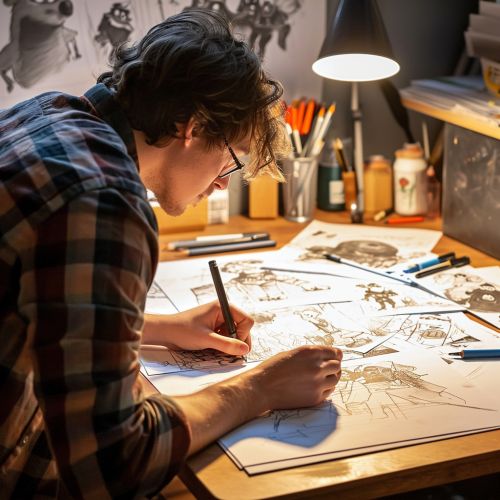Storyboard Artist
Overview
A storyboard artist, also known as a visualizer, is a professional artist who creates storyboards for film production, animation, advertising, interactive media, and other visual storytelling mediums. These artists play a crucial role in pre-production processes, translating scripts or concepts into a series of images that depict the sequence of events in a story.
Role and Responsibilities
The primary responsibility of a storyboard artist is to visualize the narrative of a script or concept. They work closely with directors, producers, and writers to ensure that the visual representation aligns with the intended message and tone of the project.
Storyboard artists begin their work by reading scripts and discussing the project's visual requirements with the creative team. They then create a series of images, known as a storyboard, which outlines the sequence of events in the story. These images are often accompanied by notes or descriptions to provide additional context.
In addition to visualizing the narrative, storyboard artists also help determine the project's technical aspects. This includes camera angles, shot transitions, and lighting, which are all crucial elements in creating the desired visual effect.


Skills and Qualifications
Storyboard artists must possess a range of skills and qualifications to excel in their role. These include:
- Artistic Ability: Storyboard artists must have strong drawing skills and a good understanding of visual storytelling. They should be able to create clear and compelling images that effectively convey the narrative and mood of the story.
- Technical Knowledge: Knowledge of film production techniques, such as camera angles and shot transitions, is essential for storyboard artists. They must understand how these techniques can be used to enhance the visual storytelling.
- Communication Skills: Storyboard artists often work as part of a creative team and must be able to communicate their ideas effectively. They should also be able to accept and incorporate feedback into their work.
- Problem-Solving Skills: Storyboarding often involves finding creative solutions to visual and narrative challenges. Storyboard artists must be able to think critically and creatively to resolve these issues.
- Time Management Skills: Storyboard artists often work on tight deadlines and must be able to manage their time effectively to meet these deadlines.
Career Path
Most storyboard artists begin their careers by studying art or a related field, such as animation or film production. They often gain experience through internships or entry-level positions in the industry.
As they gain experience and build their portfolio, storyboard artists may have opportunities to work on larger and more complex projects. Some storyboard artists may choose to specialize in a particular area, such as animation or advertising, while others may choose to work as freelance artists.
Impact on the Industry
Storyboard artists play a crucial role in the visual storytelling industry. By visualizing the narrative, they help ensure that the final product aligns with the creative vision of the project. They also contribute to the efficiency of the production process by helping to plan and organize the shooting or animation sequences.
